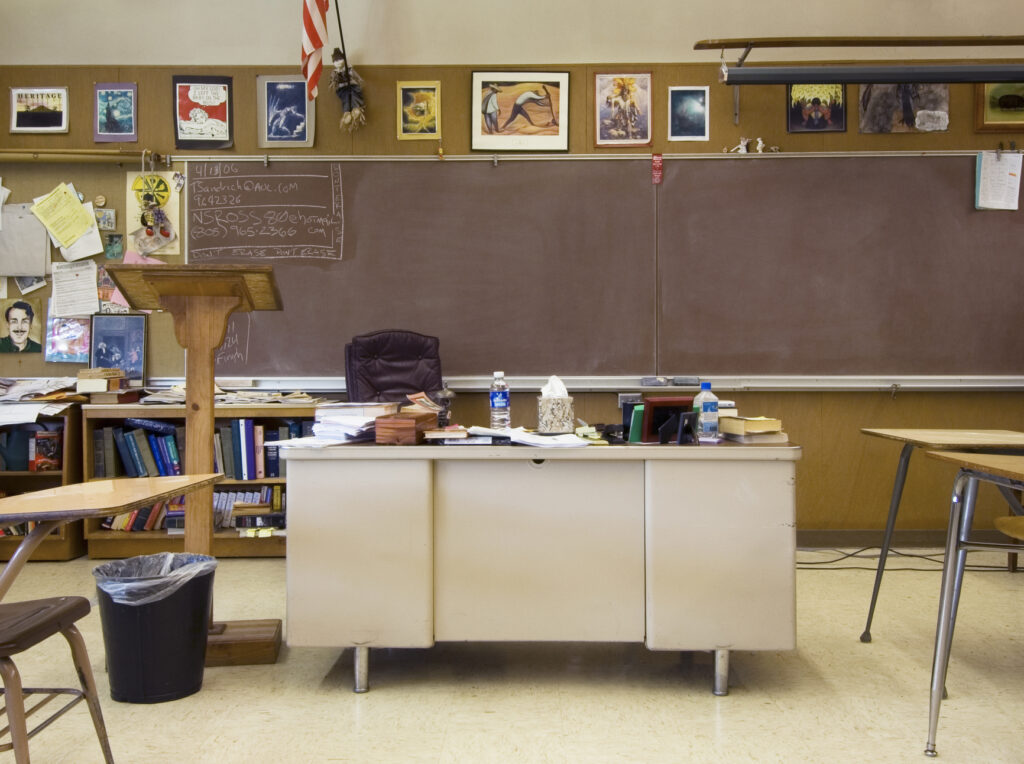
(File/Richard Ross/Getty Images)
COLUMBIA — The number of vacant teaching positions in South Carolina’s K-12 schools has dropped, though it remains far above the number of openings reported before the COVID-19 pandemic, according to an annual report released Monday.
It marks the first break in ever-increasing teacher shortages since 2019.
Teachers’ advocates cautioned that the report by the state’s Center for Educator Recruitment, Retention, and Advancement does not give the full picture of the state’s teacher shortage. With 71 of 75 surveyed districts responding, the numbers may not be 100% accurate, said advocates and the state superintendent.
Still, going from more than 1,600 open positions to 1,043 in one year is still a big improvement, advocates and the state Department of Education said Monday. But there’s more work to be done, they added.
“Our goal is nothing less than a great teacher in every classroom,” state Superintendent Ellen Weaver said in a statement.
The number of teacher vacancies fell nearly 37%, from 1,380 last fall to 872 this fall, according to the Supply and Demand Report.
The number of openings for classroom support positions dropped too. Last school year started with 233 vacant positions for librarians, counselors, psychologists and language pathologists. That number was down to 171 this fall, according to surveys conducted in September and October.
“It does look good, and it does look promising,” said South Carolina Education Association Vice President Dena Crews.
Experts could teach in SC classrooms without certification under pilot program
However, the number of vacancies is still much higher than districts reported during the fall 2019 semester, before the COVID-19 pandemic forced schools online. That year, 555 teaching positions were vacant, CERRA reported.
Reports since then kept setting new records in vacancies.
One puzzler to the break in that trend is that districts reported fewer total teaching positions statewide: They wanted 51,400 teachers this school year, compared to 52,800 total slots at the beginning of last school year.
That could come at least in part from fewer districts responding to the survey this year than last year, advocates said.
Or, the decrease in the number of teacher positions could come from districts deciding not to fill open roles. In some cases, those positions could have been funded with federal pandemic aid, which is drying up, the Palmetto State Teachers Association said in an emailed statement.
If that’s the case, “the impact on students could be devastating, especially in core areas for academic success,” the statement said.
Districts had until this fall to designate their share of $3 billion in federal COVID aid but have until 2026 to spend it all.
Because the report doesn’t break down the data by school district, “we just don’t know” the true reason for the decrease, Kathy Maness, president of the teachers’ advocacy group, told the SC Daily Gazette.
“That’s one reason why we need to invest in a more robust data workforce system,” Maness said.
The state Department of Education is working to create a more detailed report, Weaver said in her statement.
“While this report provides an interesting snapshot of South Carolina’s current teacher workforce at an aggregate level, detailed district level data is required for deeper analysis of trends in student enrollment and educator positions; teacher working conditions and exit survey data; and unique subject area, grade level, and geographic needs,” she said.
More detailed data could also give a better idea of why the number of vacancies has dropped, and why some teachers are continuing to leave the profession, advocates said.
An increase in pay likely helped.
Legislators included $200 million in the budget that took effect in July to raise the minimum pay for first-year teachers to $47,000, up from $42,500 last school year. The governor’s goal, which legislators have supported, is to get the base pay to $50,000 by 2026.
Legislators also extended state-paid yearly boosts for experience from 23 years to 28 years in the classroom, something teachers’ advocates have been requesting for years as a way of rewarding the state’s more veteran teachers.
Pay isn’t the only factor in keeping and attracting teachers, but it certainly contributes, said education association President Sherry East. Districts can, and often do, pay more than the state’s required minimum, but the increases have helped, she said.
Some teachers who left amid the pandemic’s virtual learning might be returning to their classrooms, East said. Districts reported that 335 of the teachers newly hired ahead of this semester were returning to the district after a gap of some kind, according to the report.
Other districts may have filled positions with international or virtual teachers. That raised a point of concern for both teachers’ associations, since those teachers may not be the best equipped to teach students’ material, they said.
As school vacancies exceed 1,600, proposal requires SC legislators to substitute teach
For instance, some districts contract with companies to livestream lectures to classrooms, but students lack the face-to-face instruction that is best for learning, the Palmetto State Teachers Association said.
“Such classrooms are most likely reported as having a ‘teacher,’ but the quality of instruction falls far short of what students need and deserve,” the association said in a statement.
The Legislature could take plenty more steps to continue reducing the number of vacancies, representatives for the advocacy groups said.
Legislators could revisit a proposal to make professional teaching certificates permanent, reducing the amount of bureaucracy teachers must contend with to renew their certification every five years. Or, they could create more wiggle room in teacher contracts, allowing them to back out after seeing their salaries without losing their teaching certificates, the associations said.
Limits on class sizes could help. So could yearlong, paid student-teaching programs, which would allow prospective teachers to get a better idea of what it takes to be a teacher before running a classroom on their own, East said.
“I don’t want people to think the teaching shortage is over, because it’s not,” East said.

